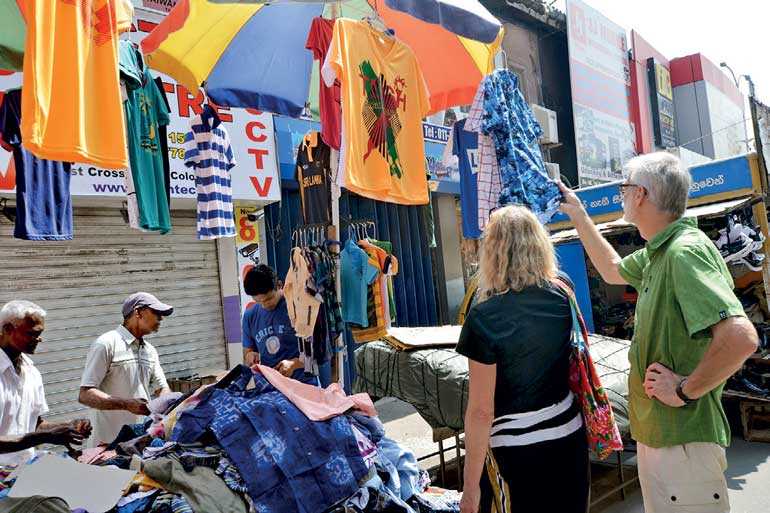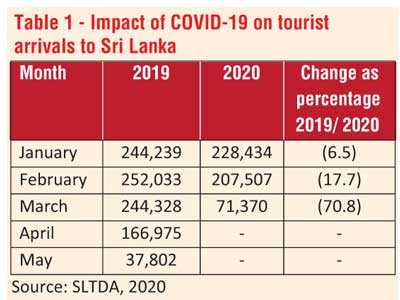Sunday Apr 20, 2025
Sunday Apr 20, 2025
Tuesday, 24 November 2020 00:15 - - {{hitsCtrl.values.hits}}

Tourism is Sri Lanka’s third largest foreign exchange earning sector, with workers’ remittances and export of textiles and apparel occupying the first and second places respectively – Pic by Shehan Gunasekara
The tourism industry is one of the worst affected economic sectors due to the outbreak of COVID-19. According to the World Tourism Organization, we have to expect around an 80% decline in tourist arrivals during this year around the world, which in turn puts 100-120 million jobs at risk.
Tourism is a major source of employment and foreign exchange earnings for many developing countries and in certain cases for developed countries as well. Therefore, an unprecedented decline in the tourism industry due to COVID-19 exacerbates the global economic challenges.
Due to the labour intensive nature of the tourism industry, possible job losses are higher than other sectors. In fact, the scale of imminent job losses in the tourism industry due to COVID-19 is not visible yet thanks to the support extended by each national government.
Decline in the tourism industry in Sri Lanka
Tourism is Sri Lanka’s third largest foreign exchange earning sector, with workers’ remittances and export of textiles and apparel occupying the first and second places respectively.
According to statistics compiled by the Sri Lanka Tourism Development Authority (SLTDA), foreign exchange earnings from tourism was $ 3.6 billion in 2019 whereas the tourism industry accounts for 4.3% of the GDP. 
The tourism industry is an important source of employment as 402,607 people are engaged in direct and indirect employment opportunities generated by the tourism as per the data compiled by SLTDA.
However, after the outbreak of COVID-19, there are no tourist arrivals to the island. Even during the first quarter of 2020, there is a drastic reduction in the tourist arrivals due to the COVID pandemic as illustrated in table 01.
As indicated in table 02, earnings from tourism have decreased by 63% from January to September 2020 in comparison with the corresponding period of 2019. The exports sector has shown impressive resilience whereas workers’ remittances have been increased marginally. (The reasons for marginal increase need to be discussed in a separate article.) Accordingly, in comparison with external sector performance such as exports, tourism seems to be the hardest hit sector.
Ongoing issues such as pay cuts, retrenchments of workers, and temporary closures of tourism enterprises are sending ripples through the industry, and those employed at small and medium level tourism enterprises are experiencing many hardships along with indirect/independent workers such as safari jeep drivers, tourist guides, handicraft sellers, etc.
The rapid assessment undertaken by UNDP together with SLTDA on the tourism sector indicates that 67% of those who lost their jobs are women. Although authorities have introduced various relief measures such as debt moratorium and working capital loans at concessionary rates, despite the limited fiscal space (budget constraints) it will be very challenging for the industry to survive until a vaccine is found for the coronavirus.
Responsive measures adopted globally
This section is focused on the some of the responsive measures adopted by various countries. Some of the measures can be enumerated as follows.
A majority of countries have introduced stimulus packages for the tourism industry which consist of measures such as concessionary loans, deferment of tax payment, wage subsidies (grants to meet a certain percentage of salaries of workers), etc. The stimulus package is one of the widely used responsive measures across the world to protect the tourism industry. The stimulus packages are mainly focused on the small and medium level tourism enterprises. Some countries (e.g. Germany and Italy, etc.) have gone to the extent of providing financial support for their national carriers as well.
The World Tourism Organisation points out the establishment of health and sanitary protocol/certification is one of the responsive measures adopted by various countries with a view to restoring the confidence of the travellers. The SLTDA has introduced ‘Safe and Secure’ certification which is issued after the assessment of compliance with health guidelines by registered tourism service providers.
Training and upskilling workers – Many countries have offered training programs for workers including laid off workers. According to Ministry of Tourism of Cambodia, they have conducted reskilling and upskilling program for tourism workers including laid off workers with the support of other stakeholders. Many other countries such as Thailand, Portugal and Israel also conducted training programs online including web based courses for hoteliers, travel agency operators, tour guides, etc. In certain instances, to be entitled for wage subsidy given by the government, workers have to attend specified training courses.
Lithuania has implemented an interesting initiative to protect the interest of travellers immediately after the outbreak of COVID-19. According to the Ministry of Economy and Innovation of Lithuania, it has created a ‘Travel Guarantee Fund’ to compensate for the losses incurred by tourists as a result of the insolvency of tour operators.
Promoting domestic tourism – domestic tourism is a key factor to support the recovery in the short term and also medium term. Due to international travel restrictions, hotels and travel agencies are focusing on the domestic market by offering discounted rates. In Sri Lanka too, there was a sudden boom in the domestic tourism after the first wave of COVID-19 was controlled.
Generating alternative revenue through different systems such as ‘Pay It Forward’ schemes – Tourism industry operators mainly hotels and travel agencies can sell vouchers at discounted rates which can be redeemed after six months or even one year later once the present crisis is contained to some extent with the invention of a vaccine. The pay it forward schemes was introduced in Manchester, UK in March 2020 immediately after the outbreak of COVID-19.
Hosting virtual tours, online yoga classes, online cooking programs, etc. In Sri Lanka, the SLTDA has initiated a ‘Couch Safari’ program that features popular national parks. However, the virtual tours can be hosted by individual tourism enterprises which enable them to generate revenue by charging a fee.
Tax reliefs and waving off/deferment of other fees – This can be considered as part of the stimulus packages which were mentioned earlier. The SLTDA, announced the waving off of their annual registration fee of all tourist establishments immediately after outbreak of COVID-19 as a relief measure.
Re-deployment of resources in the tourism industry in the short to medium term to generate revenue and ensure the survival.
Attract tourist in small groups subject to health protocols – Some countries such as Thailand are taking initiatives to re-open its borders for tourism. However, the success of such moves is doubtful because travellers have to spend the specified quarantine period and also other health guidelines which is likely to increase the cost of travel. Those who can afford the cost of such an arrangement tend to fall into the age group that has been identified as more vulnerable to the coronavirus.
Many countries have appointed working committees and task forces to look into the issues experienced by the enterprises throughout the tourism value chain and prepare recovery plans.

(The writer is a postgraduate qualified socio-economic policy researcher, can be contacted via [email protected])